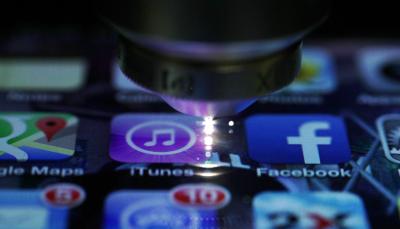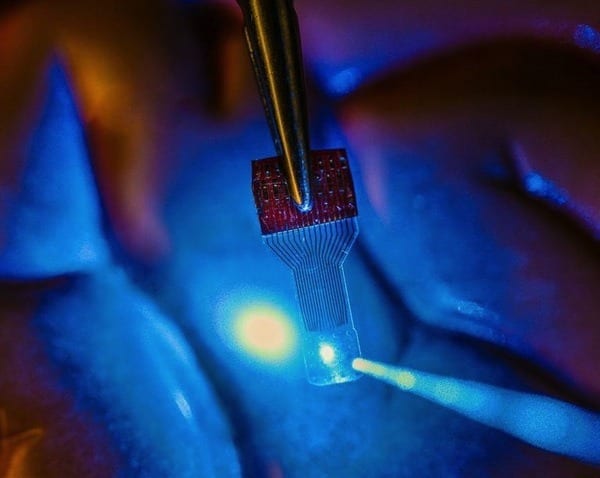Making smartphones smarter with see-through sensors
Your smartphone’s display glass could soon be more than just a pretty face, thanks to new technology developed by researchers from Montreal and the New York-based company Corning Incorporated. The team has created the first laser-written light-guiding systems that are efficient enough to be developed for commercial use. They describe their work in a paper published today in The Optical Society’s (OSA) open-access journal, Optics Express.
This revolutionary work could open up new real estate in the phone by embedding the glass with layer upon layer of sensors, including ones that could take your temperature, assess your blood sugar levels if you’re diabetic or even analyze DNA.
The researchers have used their new technology to build two completely transparent systems—a temperature sensor and a new system for authenticating a smartphone using infrared light—into a type of glass that’s currently used in most smartphones.
In addition to biomedical sensors, the technology could also eventually allow computing devices to be embedded into any glass surface, such as windows or tabletops, creating the transparent touchscreens seen in movies like Avatar and Iron Man, the researchers say.
“We’re opening the Pandora’s box at the moment,” says paper co-author Raman Kashyap, a professor of electrical engineering and engineering physics at Polytechnique Montreal in Canada. Now that the technique is viable, “it’s up to people to invent new uses” for it, he says.
Read more . . .
The Latest on: See-through sensors
[google_news title=”” keyword=”See-through sensors” num_posts=”10″ blurb_length=”0″ show_thumb=”left”]
via Google News
The Latest on: See-through sensors
- Wsdcam 113dB Bike Alarm Wireless Vibration Motion Sensor Waterproof Motorcycle Alarm with Remote, Now 31% Offon April 25, 2024 at 9:18 am
The Wsdcam 113dB Bike Alarm brings an advanced level of security to two-wheeled transport. A combination of technology-ridden features, quality performance, and affordable pricing make it an ...
- Good Vibrations: MEMS Sensor Grabs Voice Commandson April 24, 2024 at 12:40 pm
As wireless devices proliferate and systems gain processing power, the demand grows for those devices and systems to accept real-world sound inputs such as voice commands. Theres ...
- Leidos Gets U.S. Army ISR Sensor Contracton April 24, 2024 at 7:01 am
The U.S. Army has awarded Leidos a major sustainment contract for its future high-altitude intelligence, surveillance and reconnaissance (ISR) fleet as the company is competing for an upcoming program ...
- Bota Systems launches PixONE force-torque sensors for roboticson April 23, 2024 at 10:09 am
Bota Systems says it designed its new PixONE force-torque sensors for ease of integration and to keep cabling inside robotic arms.
- Unlocking sustainable success: SAS harnesses the power of IoT sensors for a better futureon April 19, 2024 at 10:08 am
Discover how SAS uses IoT sensors to drive sustainability through energy optimization. Explore the potential and impact of IoT sensors in modern society.
- Bota Systems to showcase its latest sensors at Robotics Summiton April 18, 2024 at 11:48 am
Bota Systems will be at Booth 315 on the show floor at the Robotics Summit & Expo, which takes place on May 1 and 2, 2024.
- Indie creatures to the core, David and Nathan Zellner cut their own path through the wildon April 17, 2024 at 1:06 pm
The filmmaking brothers have found a deep emotional connection to a family of mythical creatures led by an unrecognizable Riley Keough and Jesse Eisenberg.
- Ultra-resilient flexible sensors break new ground in pressure detectionon April 16, 2024 at 7:05 am
In recent advancements, flexible pressure sensors have been developed to mimic human skin's sensitivity, significantly benefiting fields like ...
- Lectric XPress e-bike launched as $999 torque sensor commuter electric bikeon April 16, 2024 at 12:20 am
The Lectric XPress is the newest model launched by Lectric Ebikes and is set to turn the commuter e-bike market on its head ...
- NantHealth gets grant for patient data exchange system with configurable sensors for healthcare providerson April 15, 2024 at 6:16 am
Discover how NantHealth's patented system revolutionizes patient data exchange through sensors and a data exchange engine, ensuring efficiency and privacy.
via Bing News











